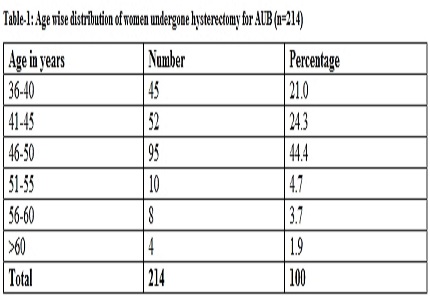A clinicopathological study of correlation of clinical, sonological and histopathological findings following hysterectomy for abnormal uterine bleeding based on PALM-COEIN Classification
Abstract
Background: To identify the proportion of different causes of Abnormal Uterine Bleeding in women undergoing hysterectomy according to the PALM COEIN classification proposed by FIGO.
Methods: Collection of data was done from the medical records of women who underwent hysterectomy for Abnormal Uterine Bleeding in the study period from January 2015 to June 2016. Women who underwent planned abdominal hysterectomy and laparoscopy assisted vaginal hysterectomy for Abnormal Uterine Bleeding were included in the study. The clinical, sonological and histopathologic findings were analyzed so as to identify the proportion of different causes of Abnormal Uterine Bleeding in women undergoing hysterectomy. Causes of Abnormal Uterine Bleeding were categorized by calculating the percentage according to the PALM-COEIN classification.
Results: A total of 214 women with Abnormal Uterine Bleeding underwent hysterectomy out of which 148 had planned abdominal hysterectomy and 66 had planned laparoscopy assisted vaginal hysterectomy, in the study period. AUB-L was the commonest histopathology (38.3%cases) followed by AUB-O(22%cases) and about 21.5% had adenomyosis. Heavy menstrual bleeding was the commonest presenting symptom (24.3% cases) while 40% and 36% had irregular and frequent menstrual bleeding respectively.
Conclusion: FIGO has proposed this new standardized terminology to provide uniform conduct of research as data could be compared both nationally and internationally without any confusion and classify the causes of Abnormal Uterine Bleeding according to PALMCOEIN and identify the relative proportions of each cause. This will help in further research for comparative and epidemiological studies in various populations. More research is needed to identify the riskfactors for leiomyoma in our region as it more prevalent here.
Downloads
References
2. Fraser IS, Critchley HO, Broder M, Munro MG. The FIGO recommendations on terminologies and definitions for normal and abnormal uterine bleeding. Semin Reprod Med. 2011 Sep;29(5):383-90. doi: 10.1055/s-0031-1287662. Epub 2011 Nov 7.
3. Abnormal Uterine Bleeding. [Internet] 2014 May. Available from: http: //www.acog.org/-/media/Districts/District-VIII/AbnormalUterineBleeding.pdf
4. Rizvi G, Pandey H, Pant H, Chufal SS, Pant P. Histopathological correlation of adenomyosis and leiomyoma in hysterectomy specimens as the cause of abnormal uterine bleeding in women in different age groups in the Kumaon region: A retroprospective study. J Midlife Health. 2013 Jan;4(1):27-30. doi: 10.4103/0976-7800.109631.
5. Jonathan arnold,Srivani saravanan,Journal of Evolution of Med and Dent Sci/ eISSN- 2278-4802, pISSN- 2278-4748/ Vol. 4/ Issue 63/ Aug 06, 2015
6. Twiss JJ. A new look at abnormal uterine bleeding. Nurse Pract. 2013 Dec 10;38(12):22-30; quiz 31. doi: 10.1097/01.NPR.0000437574.76024.ef.
7. Mohammed N, Prejisha B. A Study of Correlation of Etiological and Histopathological Findings in Females Undergoing Hysterectomy for Abnormal Uterine Bleeding - in accordance with Palmcoein Classification. Paripex-Indian Journal of Research. 2014 Nov; 3(11): 76-77.
8. Jaleel R, Khan A, Soomro N. Clinicopathological study of abdominal hysterectomies. Pak J Med Sci 2009;25:630-4.
9. Sobande AA, Eskandar M, Archibong EI, Damole IO. Elective hysterectomy: a clinicopathological review from Abha catchment area of Saudi Arabia. West Afr J Med. 2005 Jan-Mar;24(1):31-5.
10. Clarke A, Black N, Rowe P, Mott S, Howle K. Indications for and outcome of total abdominal hysterectomy for benign disease: a prospective cohort study. Br J Obstet Gynaecol. 1995 Aug;102(8):611-20. [PubMed]
11. Doraiswami S, Johnson T, Rao S, Rajkumar A, Vijayaraghavan J, Panicker VK. Study of endometrial pathology in abnormal uterine bleeding. J Obstet Gynaecol India. 2011 Aug;61(4):426-30. doi: 10.1007/s13224-011-0047-2. Epub 2011 Sep 22.
12. Rather GR, Gupta Y, Bardhwaj S. Patterns of Lesions in Hysterectomy Specimens A Prospective Study. JK Science. 2013; 15(2): 63-68.
13. Perveen S, Tayyab S. Clinicopathological review of elective abdominal hysterectomies. J Sur Pak2008;13:26-9.
14. Bashir R, Parveen Z, Sultana R, Khan B. A two years audit of complications of hysterectomy at Ayub Teaching [PubMed]Hospital Abbottabad. J Ayub Med Coll Abbottabad. 2005 Apr-Jun;17(2):47-9.

Copyright (c) 2016 Author (s). Published by Siddharth Health Research and Social Welfare Society

This work is licensed under a Creative Commons Attribution 4.0 International License.


 OAI - Open Archives Initiative
OAI - Open Archives Initiative



















 Therapoid
Therapoid

